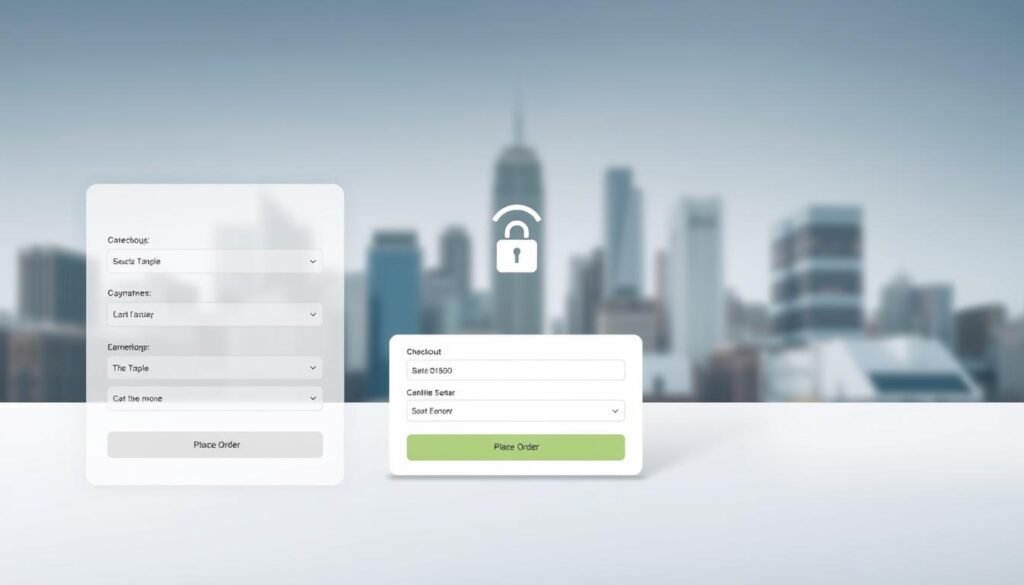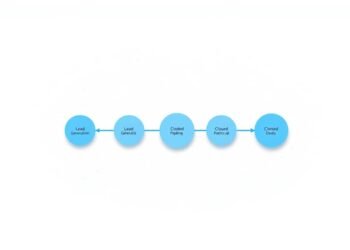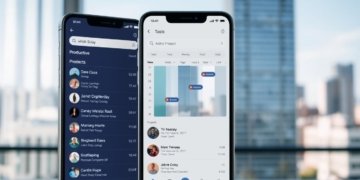What if you could boost your sales without spending extra on ads? Many businesses focus on attracting new visitors while overlooking the goldmine in their existing traffic.
Expedia increased profits by $12 million simply by removing one form field. Going saw a 104% jump in conversions by refining their call-to-action. The average conversion rate across industries hovers between 2.5% and 4.3%—small tweaks can make a big difference.
This guide reveals 13 proven strategies to maximize the value of your current audience. From UX adjustments to psychological triggers, these tactics help turn browsers into buyers.
Key Takeaways
- Small changes like form optimization can yield massive revenue gains
- Most industries see conversion rates below 5%, leaving room for growth
- CTA refinements doubled conversions for some businesses
- Existing traffic often holds untapped potential
- User experience directly impacts purchasing decisions
Introduction
The difference between 2% and 5% isn’t just a number—it’s revenue. A PPC campaign with a 5% conversion rate generates 2.5x more leads than one at 2%, slashing cost-per-lead from $250 to $100. That’s the power of refining what you already have.
Friction points sabotage results. A single confusing form field or slow load time can deter visitors convert. Quantum Metric’s research shows analyzing 100+ customer signals—like scroll depth and hesitation clicks—reveals these hidden barriers.
Short-term wins matter. Adjusting button colors or simplifying checkout can yield immediate lifts. But sustainable growth requires understanding user behavior patterns over time. Heatmaps and session recordings uncover recurring drop-off points.
Data drives decisions. A/B testing headlines or layouts transforms guesses into strategies. The goal? Turn every visit into value, whether through sales, sign-ups, or engagement.
How to Improve Conversion Rate Without More Traffic: Start Here
Starbucks’ holiday campaign proves specificity drives action. Their BOGO offer mentioned exact drink pairings, making the deal irresistible. This precision creates a seamless journey from ad to checkout.
Message match matters. When ads promise one thing but landing pages deliver another, visitors bounce. Aligning headlines, images, and offers keeps users engaged.
Design for how eyes move. Z-shaped patterns work for simple pages, while content-rich pages benefit from F-shaped scanning. Place key elements along these natural sightlines.
Above-the-fold space is prime real estate. Hero images with clear value propositions increase conversion by 24%. Put your best offer where visitors look first.
Broomberg boosted leads 72% with targeted popups. Timed triggers based on scroll depth or exit intent recover abandoning visitors.
Heatmaps reveal engagement zones. These visual tools show where users click, scroll, and hesitate. Fixing dead zones improves the experience.
Start with these fundamentals before diving deeper. They lay the groundwork for sustainable growth.
1. Optimize Your Calls to Action (CTAs)
Going’s 104% conversion jump started with one critical change: sharper CTAs. A compelling call to action bridges the gap between browsing and buying. It’s not just about the words—it’s about timing, design, and psychology.
Use Clear, Action-Oriented Language
Generic phrases like “Sign up” underperform. Going switched to “Get My Free Ebook,” emphasizing the user’s benefit. Nike’s basketball shoe CTAs use verbs like “Dribble Faster” or “Jump Higher,” tying action to product value.
Test Button Colors and Placement
Color contrasts drive clicks. Blue websites often see lifts with orange buttons—the complementary hues stand out. Shopify’s floating cart button, always visible during scrolling, increased add-to-cart rates by 18%.
Create Urgency with Time-Sensitive CTAs
Exit-intent popups with countdown timers (“Offer expires in 5:00!”) recover abandoning visitors. Broomberg used this tactic to boost leads by 72%. Pair urgency with scarcity (“Only 3 left!”) for higher conversions.
2. Leverage Social Proof to Build Trust
Trust drives decisions—34% of shoppers rely on testimonials before purchasing. When visitors see others vouch for your brand, hesitation fades. This psychological trigger, called social proof, turns uncertainty into action.
Showcase Customer Reviews and Testimonials
Rhode Skin Care increased sales by letting shoppers filter reviews by skin type. This specificity builds credibility. Video testimonials work best—show real customers explaining results in their own words.
Highlight Case Studies and Success Stories
Northwestern University boosted conversions 270% by detailing student outcomes. Case studies with metrics (“Increased revenue by 40% in 3 months”) provide tangible proof. Place these near CTAs for maximum impact.
Display Trust Badges and Security Seals
Position payment badges (Visa, PayPal) and SSL certificates near checkout buttons. PCI compliance requires visible security seals. A Baymard Institute study found 18% of cart abandonments stem from trust concerns.
3. Simplify Your Checkout Process
Every extra click in checkout costs you customers—27% abandon carts due to lengthy forms. The path to purchase should feel effortless, not like a tax audit. Small tweaks here yield outsized returns.
Reduce Form Fields to the Essentials
Shop Pay’s one-click system proves less is more. Autofill APIs like Google’s Address Autocomplete cut errors by 20%. Only ask for what’s critical—name, email, and shipping details.
Recess Beverages redesigned their returns policy page by removing redundant fields. This reduced support queries by 15%. Breadcrumb forms (showing progress like “Shipping → Payment → Review”) ease multi-step anxiety.
Offer Guest Checkout Options
Forced account creation loses 34% of potential buyers. Brands like Nike saw a 45% lift by adding “Continue as Guest.” Save registration prompts for post-purchase emails instead.
Provide Multiple Payment Methods
Stripe users convert 18% higher than PayPal for digital goods, but local options like Klarna dominate in Europe. Display icons for Visa, Apple Pay, and Afterpay to reassure shoppers.
A/B test placement—burying payment options below the fold increases abandonment. Top performers like Allbirds place them beside the order summary.
4. Improve Page Load Speed
A single second delay can slash conversions by 7%, making speed a silent revenue killer. Research shows a 106% bounce probability when pages take 6+ seconds to load. Mobile users are even less patient—53% abandon sites exceeding 3 seconds.
Compress Images and Videos
Media files often bloat load times. WebP images are 26% smaller than JPEGs without quality loss. Tools like TinyPNG automate compression, while lazy loading delays off-screen images until needed—ideal for product galleries.
Minify CSS and JavaScript
Unused code slows down your site. GTMetrix flags redundant scripts during performance audits. Minification tools like UglifyJS strip whitespace and comments, shrinking file sizes by up to 30%.
Use a Content Delivery Network (CDN)
Cloudflare’s CDN caches your site on global servers, cutting latency by 50%. Configuration takes minutes: point your DNS to Cloudflare, enable auto-minify, and activate Argo Smart Routing for real-time traffic optimization.
5. Enhance Mobile User Experience
Mobile devices now drive over 60% of web traffic, making optimization non-negotiable. A single pinch-to-zoom frustration can erase trust. Google’s mobile-friendly test tool flags these pitfalls—fixing them boosts both user satisfaction and search rankings.
Prioritize Mobile-First Design
Oyster HR increased conversions 33% by resizing hero images for smaller screens. Avoid horizontal scrolling—vertical layouts align with natural thumb movement. Hamburger menus work, but label them “Menu” for clarity.
Simplify Navigation for Smaller Screens
Place key CTAs within thumb reach (bottom-right for right-handed users). AMP speeds up product pages by stripping non-essential elements. Autofill forms with browser-saved data to reduce typing.
Ensure Fast Load Times on Mobile
3G still dominates rural areas. Compress images further for mobile—50KB max per image. Lazy-load videos to prevent delays. Test with Google’s PageSpeed Insights to pinpoint bottlenecks.
6. Use High-Quality Visuals and Media
Visuals aren’t just decoration—they’re conversion drivers. GoFundMe’s abstract imagery increased donor trust by 19%, proving that strategic design choices influence decisions. Whether it’s product demos or human-centric photos, every pixel should guide visitors toward action.
Incorporate Product Videos and 360-Degree Views
Shoppers who watch videos are 1.8x more likely to buy than those who view static images. Warby Parker’s virtual try-on feature boosted sales by 25% by letting customers “test” glasses digitally. For complex products, 360-degree views reduce returns by 22%.
Optimize Images for Clarity and Speed
Shopify’s global CDN ensures fast-loading visuals by automatically resizing files based on device type. Use WebP format for 30% smaller file sizes without quality loss. Always add descriptive alt text—it aids SEO and accessibility.
Use Human Faces to Build Connection
Hero images with faces looking toward CTAs increase clicks by 10%. This subtle cue directs attention while building trust in your brand. For nonprofits, authentic donor photos (like GoFundMe’s strategy) outperform stock imagery by 35%.
7. Implement A/B Testing for Continuous Improvement
Data doesn’t lie—small tweaks can lead to big wins. Unbounce’s study of 20,000 pages shows brands double conversions by testing strategies like button colors or headlines. Start with Google Optimize: link it to Analytics, define variants, and set traffic splits.
Test Headlines and Copy Variations
Paro’s abandoned cart emails saw a 22% lift by testing layouts. Try two versions—one urgency-driven (“Last chance!”) and one benefit-focused (“Your cart is waiting”). Use heatmaps to validate which draws more clicks.
Experiment with Layouts and Design Elements
Statistical significance matters. Wait until tests reach 95% confidence (about 1,000 visitors per variant). Multivariate tests work but require more traffic—stick to A/B tests for smaller sites.
Analyze Results to Inform Future Changes
Winners become your new default. Losers reveal what to avoid. Tools like Hotjar replay sessions to see why users preferred one way over another. Iterate relentlessly—testing never stops.
8. Personalize the User Experience
Personalization isn’t a luxury—it’s what modern shoppers expect. A Salesforce study shows 66% of customers demand tailored engagements. When done right, it makes every visitor feel like the only person in the room.
Segment Audiences for Targeted Messaging
Amazon’s “Frequently Bought Together” algorithm boosts sales by 35%. It groups buyers by purchase history and browsing patterns. Klaviyo’s behavioral emails work similarly—sending cart reminders when users linger on product pages.
Recommend Products Based on Behavior
Clare Paint’s personalized discount offers increased conversions by 28%. Their AI analyzes color preferences from past orders. Dynamic quizzes then suggest complementary shades, creating a curated experience.
Use Dynamic Content for Relevance
Geo-targeting adjusts offers by location. A surf shop might highlight wetsuits to coastal visitors but boards to inland browsers. Always disclose cookie usage—72% of shoppers prefer transparent data collection.
9. Reduce Friction in the User Journey
IKEA’s menu redesign proves simplicity boosts conversions. Their revamped navigation cut clicks to checkout by 30%, lifting sales by 15%. Littledata’s research shows 68% of shoppers abandon sites with confusing layouts. The smoother the journey, the higher the conversions.
Streamline Navigation and Menus
IKEA replaced nested menus with visual categories. Shoppers now find products in 2 clicks instead of 5. Use mega menus for complex sites—Amazon’s dropdowns reduce search time by 40%.
Add Progress Indicators for Multi-Step Processes
Asos’ checkout tracker shows steps like “Shipping” and “Payment.” This transparency reduced cart abandonment by 22%. Breadcrumb navigation works similarly—highlighting where users are in the friction-prone funnel.
Conduct User Testing to Identify Pain Points
UserTesting.com’s session recordings reveal rage clicks—repeated taps on non-clickable elements. Fixing these points increased conversions by 18% for Sephora. Optimize 404 pages too—add search bars or popular product links.
10. Offer Incentives to Encourage Conversions
Shoppers love feeling rewarded—strategic incentives can turn browsers into buyers. Psychological triggers like exclusivity and instant gratification remove hesitation. The key is timing these offers precisely.
Provide Free Shipping or Discounts
60% of carts get abandoned when free shipping isn’t offered. Wayfair’s genius move? Showing a progress bar: “Spend $25 more for free delivery.” This threshold approach increased average order values by 28%.
Bumble’s first-purchase discount strategy works similarly. New users get 20% off when signing up—a win-win that boosts immediate conversions while collecting email leads.
Create Limited-Time Offers
Scarcity plugins like Hurrify add countdown timers to product pages. Seeing “3 left at this price!” nudges visitors to purchase now. Fashion Nova uses this tactic during flash sales, creating 3x higher conversion spikes.
Use Exit-Intent Popups to Retain Visitors
GDPR-compliant popups recover 15% of abandoning traffic. Best practices: Offer a discount code when users move toward closing the tab. Pair it with a short time limit (“Offer expires in 10 minutes”).
Push notifications work too. Send reminders about viewed items 1 hour later—this retargeting tactic brings back 8% of window shoppers.
11. Optimize Product Pages for Clarity
Clear product pages turn curiosity into sales. Visitors need quick answers to make confident decisions. The right mix of visuals, details, and trust signals removes hesitation.
Write Detailed, Benefit-Focused Descriptions
Apple masters this by pairing technical specs with real-world advantages. Instead of “16GB RAM,” they say “Edit 4K videos without lag.” This bridges features to user benefits.
Zappos takes it further with 360-degree product views. Shoppers inspect shoes from every angle, reducing returns by 22%. Include zoom functionality for textile close-ups.
Include High-Resolution Images and Videos
Allbirds uses lifestyle shots showing sneakers in action—hiking, commuting, relaxing. Their demo videos highlight breathability by placing a hand inside the shoe. This visual proof builds trust.
Schema markup boosts visibility. Tag prices, availability, and reviews for rich snippets. Google Shopping ads using this data see 35% higher click-through rates.
Add FAQs to Address Common Concerns
HelpLab data shows FAQ interactions increase conversions by 18%. Allbirds answers sustainability questions upfront—materials, carbon footprint, recycling. This preempts objections.
Size charts with measurement guides cut returns. ASOS places them beside the “Add to Cart” button. Include fit recommendations like “Runs small, order half size up.”
12. Improve Your Site’s Search Functionality
A powerful search function can make or break a shopper’s experience. With 80% of visitors bouncing due to poor results, optimizing this tool is critical. Fast, accurate queries keep users engaged and drive sales.
Ensure Fast and Accurate Search Results
Nordstrom’s visual search lets users upload photos to find similar items. Tools like Algolia’s API deliver results in milliseconds. Typo tolerance—like Google’s “Did you mean?”—reduces frustration.
Add Filters and Sorting Options
Open Spaces organizes results by price, color, and ratings. Dynamic filters help visitors narrow choices quickly. Pair this with auto-suggestions to guide users.
Include Suggested Products for Empty Searches
When no matches exist, showcase trending products. Amazon’s “Explore more” section recaptures lost interest. Optimize “no results” pages with search bars and popular categories.
13. Monitor and Analyze User Behavior
Behavioral analytics transform guesswork into actionable strategies. Tools like Quantum Metric track real-time user behavior, revealing patterns that boost engagement. Small tweaks based on these insights can lift rates significantly.
Use Heatmaps to Track Engagement
Crazy Egg and Hotjar visualize where visitors click, scroll, and hesitate. Booking.com’s heatmaps showed 40% of users missed their “Book Now” button—relocating it increased conversions by 15%.
Identify Drop-Off Points in Funnels
Google Analytics 4 highlights where visitors abandon carts or forms. Scroll depth tracking reveals if key content goes unseen. Fixing these leaks recovers lost revenue.
Adjust Strategies Based on Data Insights
CRM integration merges behavioral data with customer profiles. A/B test changes like Amazon’s checkout redesign, which reduced steps and boosted sales by 12%.
Conclusion
Mastering these strategies unlocks hidden potential in your existing traffic. Small changes—like Going’s 104% CTA boost—produce outsized results when tested and refined.
Focus on quick wins first. Optimize CTAs, simplify checkout, and leverage social proof. These tweaks often deliver immediate lifts. Then, dive deeper with behavioral analysis and personalization.
Continuous optimization is key. Tools like heatmaps and A/B testing reveal what works. AI-driven personalization is the next frontier, tailoring experiences in real time.
Start today. Pick one tactic, measure its impact, and iterate. Your conversion rate won’t skyrocket overnight—but consistent refinement builds lasting success.
FAQ
What’s the best way to optimize CTAs for higher conversions?
Use clear, action-driven language like “Buy Now” or “Get Started.” Test button colors—red often outperforms green—and place them above the fold for visibility.
How does social proof influence purchase decisions?
Reviews, testimonials, and trust badges build credibility. For example, Amazon displays star ratings to reassure shoppers, boosting confidence in buying.
Why does checkout friction hurt conversion rates?
Long forms or forced account creation frustrate users. Brands like Nike simplify checkout with guest options and auto-fill fields, reducing abandonment.
Can page speed really impact sales?
Yes. Walmart found every 1-second improvement in load time increased conversions by 2%. Compress images and use CDNs to keep speeds under 3 seconds.
What mobile design elements improve conversions?
Thumb-friendly buttons, collapsed menus, and fast-loading pages work best. Target’s mobile site uses large CTAs and streamlined navigation for seamless browsing.
How do visuals affect user engagement?
High-quality images and videos, like Apple’s product demos, increase trust. Human faces in testimonials also create emotional connections.
Should I A/B test my landing pages?
Absolutely. Airbnb constantly tests headlines and layouts. Small changes, like a brighter CTA button, can lift conversions by 10-20%.
What’s the benefit of personalized recommendations?
Netflix’s tailored suggestions drive 80% of watched content. Use browsing data to show relevant products, like Amazon’s “Frequently Bought Together” section.
How can I reduce cart abandonment?
Offer free shipping thresholds (e.g., “Spend more for free shipping”) or exit-intent popups with discounts, similar to Sephora’s strategy.
Why is search functionality important for e-commerce?
Over 30% of users rely on search. ASOS uses predictive text and filters to help shoppers find products faster, cutting bounce rates.










